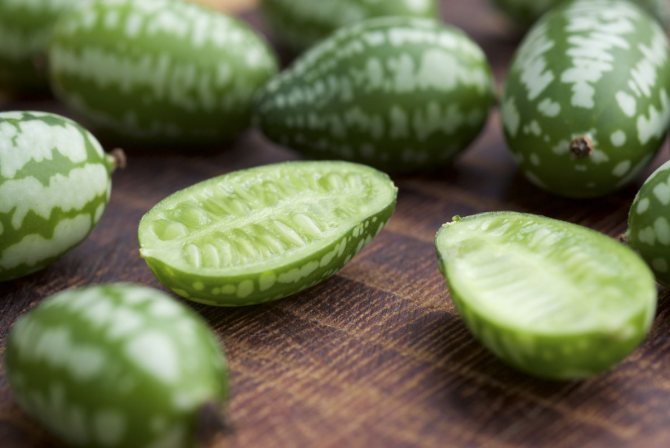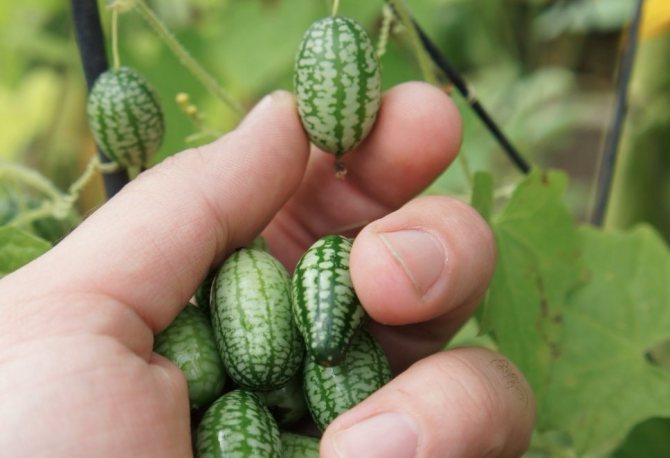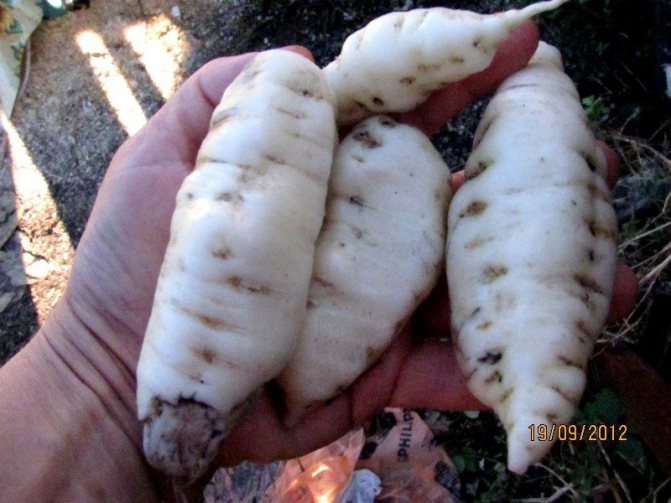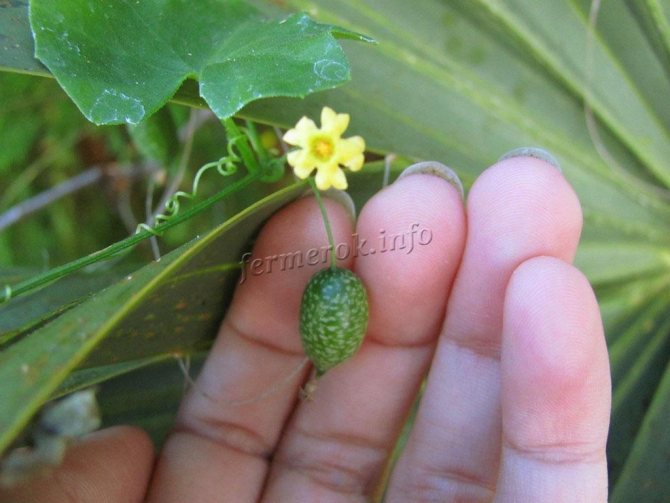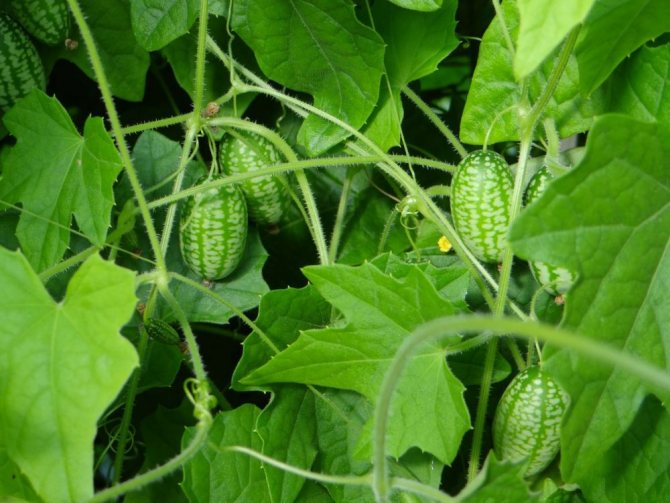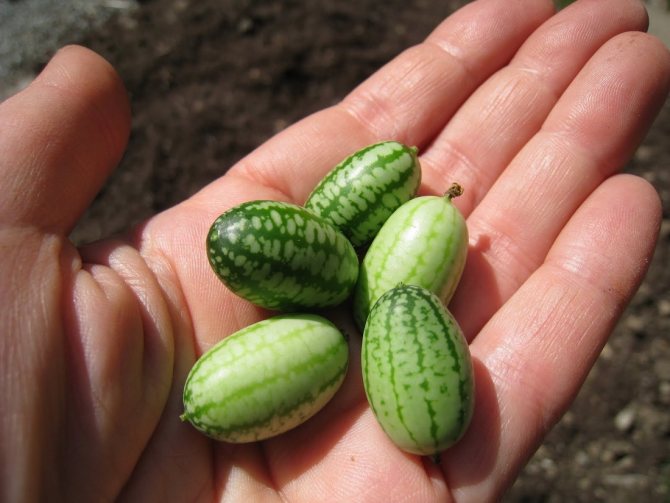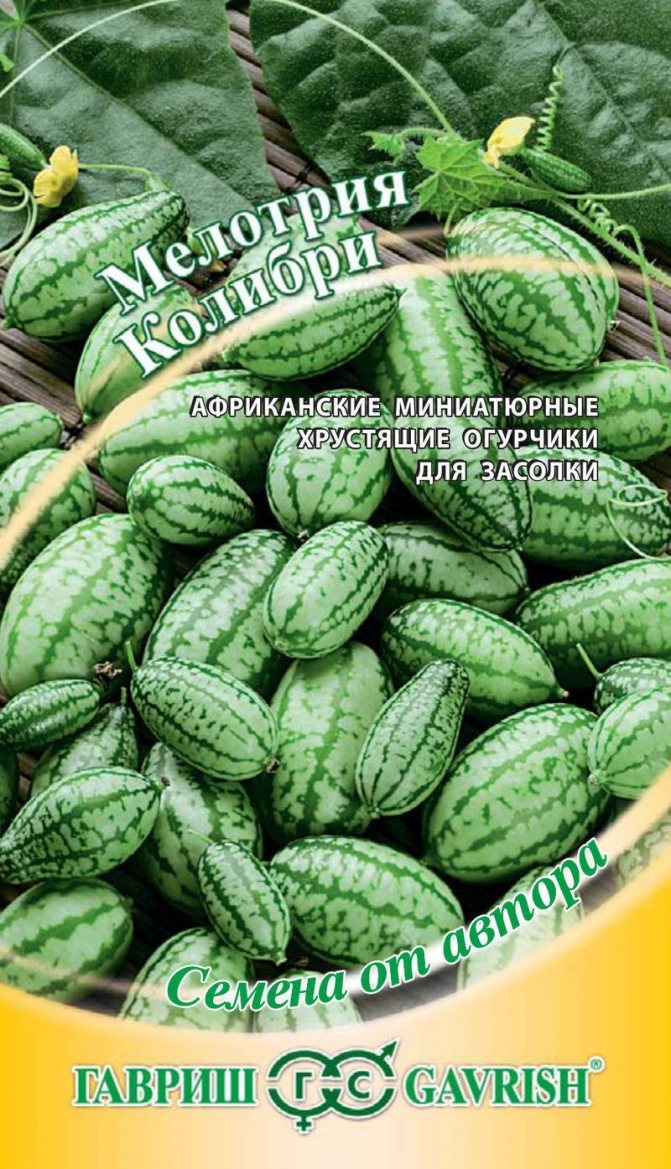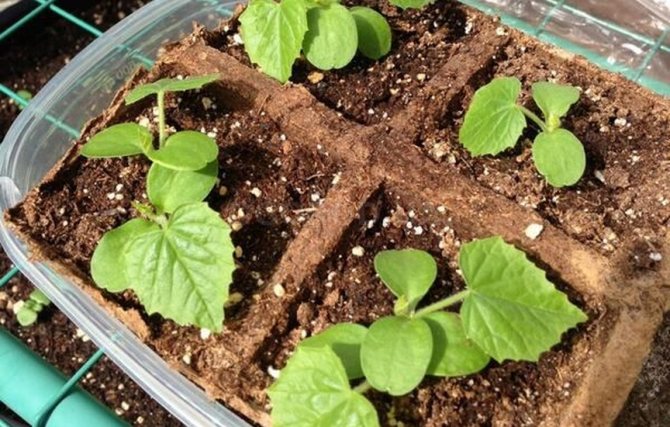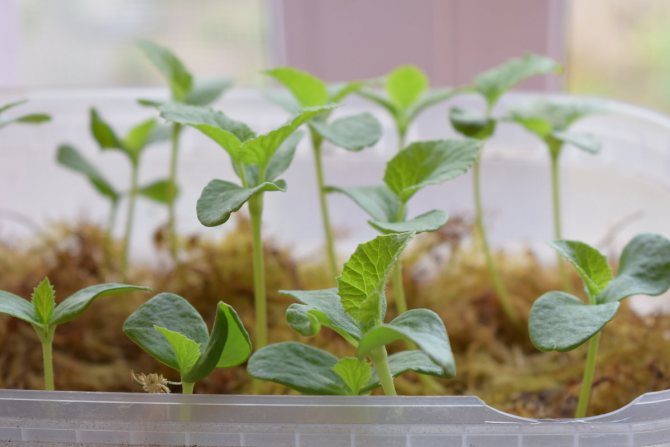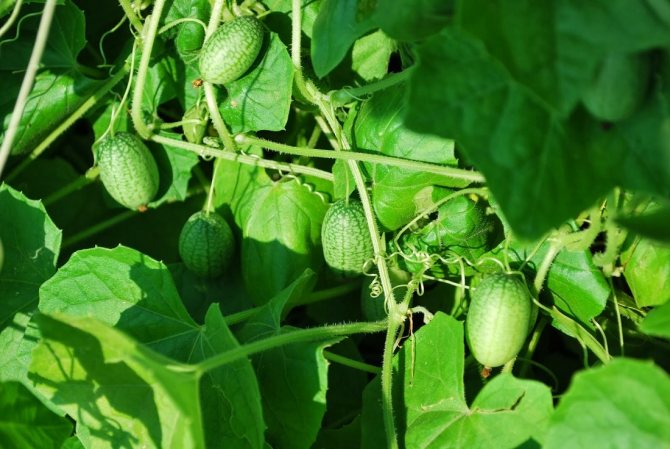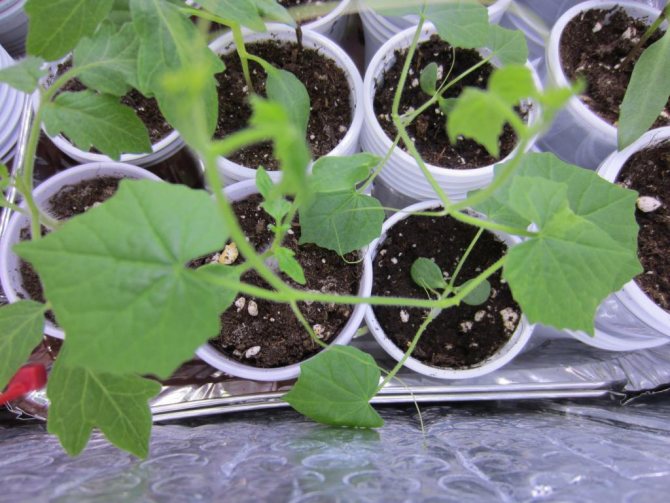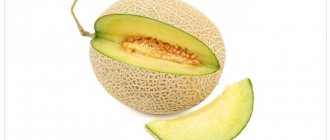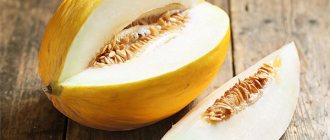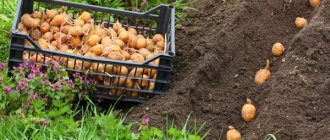One of the most popular garden novelties has become rough melotria - a creeping vine imported from African countries, the fruits of which, similar to our cucumbers, can be eaten.
Many summer residents have already appreciated the advantages of an exotic guest - unpretentious content, high productivity and visual appeal. Those who have not yet heard of Melotria should get to know it better.
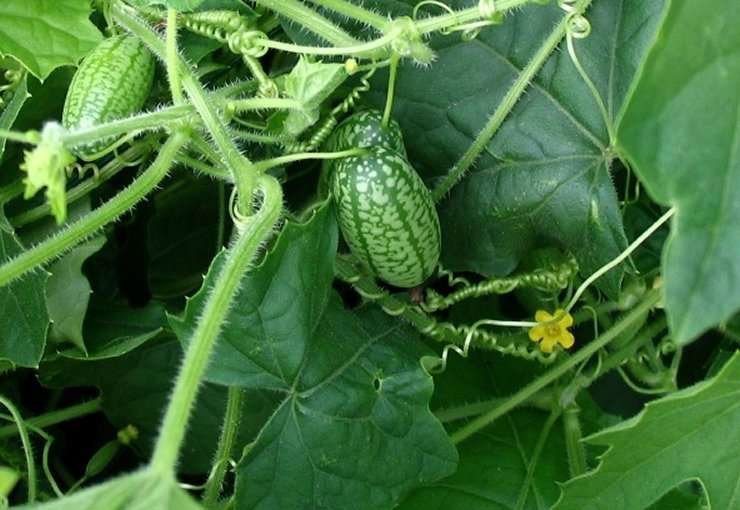
Biological description of melotria rough
Melotria rough - a plant of the pumpkin family. It is common in equatorial Africa. This is an annual plant, its stems reach a length of 3 m. The leaves of the melotria are triangular in shape, with slight pubescence. The flowers of the plant are small, bright yellow, funnel-shaped, heterosexual. The males are gathered in bunches, and the females grow one by one.
Melotria begins to harvest in July. Its fruits are small, up to 3 cm, oval, green with a speckled pattern. Edible. It tastes like a cucumber, but has a sour taste.
It is recommended to harvest the fruits on the second or third day, then they will be tastier.
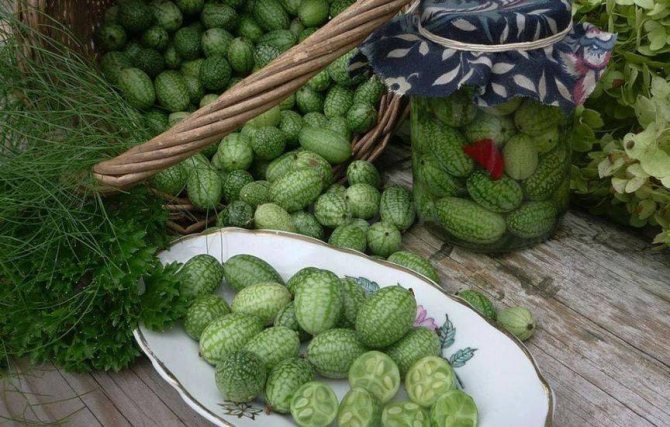

Features of growing melotria rough
The cultivation of rough melotria is in many ways similar to the cultivation of cucumbers. In view of the warmth of love, it is customary to plant melotria in the ground with strong bushes of seedlings.
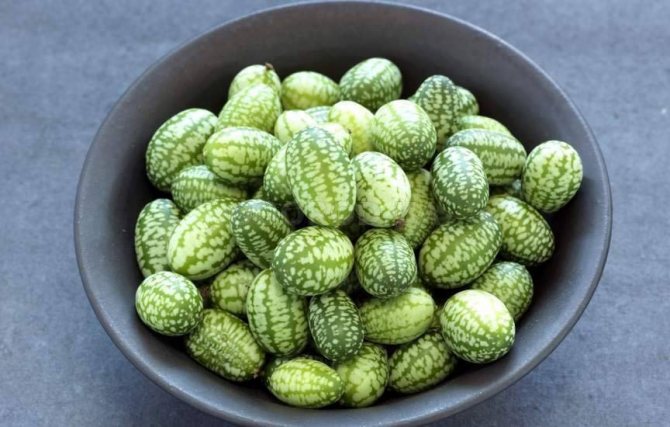

Growing seedlings of melotria rough:
Seeds are sown 20 days before the planned planting in the ground. They are buried in the soil no more than 1 cm, after which they are watered with warm water.
1. Fill small glasses with a volume of about 200 ml with nutrient soil mixture.
2. The substrate is moisturized abundantly.
3. Very small, cucumber-like seeds of melotria rough, are sown to a depth of 0.5-0.7 cm.
4. To create a favorable greenhouse microclimate, crops are covered with thin polyethylene or a glass lid. The greenhouse is placed on a sunny windowsill.
5. Sprouts appear in 3-4 days, after which the shelter is removed, and the seedlings are provided with proper care - regular watering and systematic loosening of the soil.
6. When the plants grow up to 3-5 cm in height, you can briefly open the window, thereby accustoming the seedlings to natural aeration. In mid-May, the seedlings are transferred to the garden bed.
The site for melotria is sunny and windless, the one where tomatoes, onions, and legumes grew last season. Due to common diseases, Melotria should not be planted after its "relatives" - squash, cucumbers, pumpkin, squash. After transplanting, temporary shelter should be provided for young plants in case of an unexpected cold snap.
It is also allowed to sow crop seeds directly into the soil, but in this case, fruiting is significantly delayed. Such a rough planting of melotria is most often used for decorative purposes, for decorating gazebos and arches.
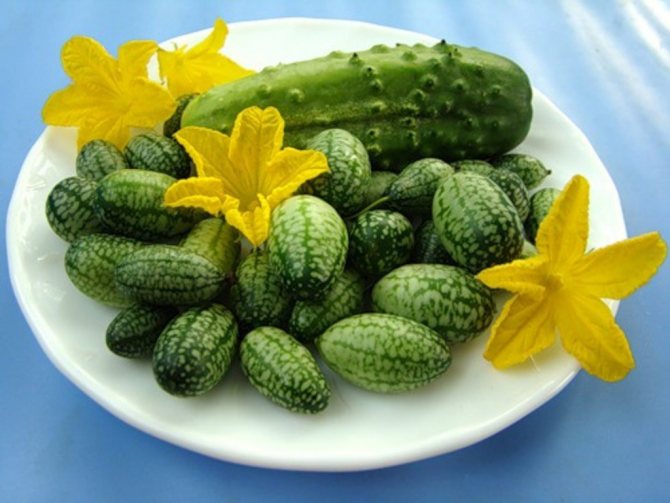

Rules for the care of melotria rough
In the middle liana, the exotic liana feels quite comfortable, so caring for it does not require much effort:
1. Like all pumpkin seeds, melotria is hygrophilous, therefore it should be watered often and abundantly, but at the same time it should not be waterlogged.
After the procedure, the soil at the base is shallowly loosened, preventing the formation of a dry soil crust. To preserve heat and moisture, it is useful to mulch the near-trunk zone with humus.
2. To increase the yield, it is recommended to feed the liana with phosphorus-potassium fertilizers. In the event that melotria is grown for decorative purposes, it is better to use nitrogen-based feeding for nutrition. This component contributes to the active growth of green mass.
3. Since the lashes of melotria grow in length up to 3 m, it is necessary to prepare in advance an appropriate support for the vines, which can serve as a fence, a fence made of a chain-link netting, a gazebo, pergola or arch.
When landing in an open area, you can build a structure of long stakes, similar to a wigwam. Gradually braiding the stakes, melotria will turn the support into an original garden decoration.
4. In order to avoid contamination of the culture with powdery mildew, it is recommended to treat it with a solution of tar or laundry soap twice during the planting season.
Healthy and well-groomed melotria looks very impressive in landscape design. Even when the tops of other pumpkin plants wither and wither, the beautiful liana retains its attractiveness.
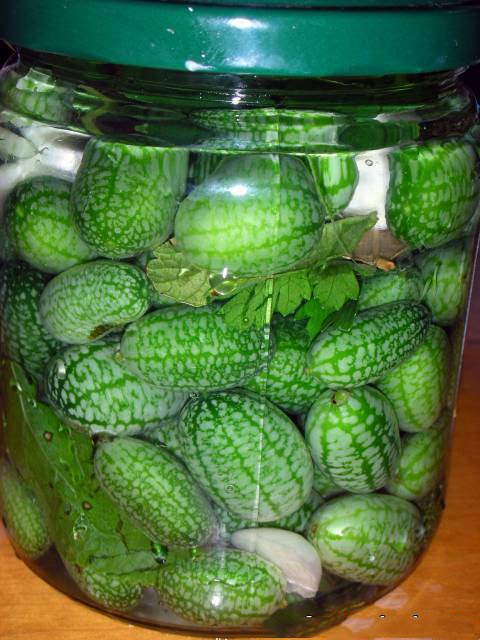

Harvesting melotria rough
Melotria ripens quickly, the first fruits appear two to three weeks after planting. Since the fruits tend to overripe, they are harvested when they reach 2-3 cm in length. Up to five kilograms of fruits are harvested from one bush of melotria.
The fruit should be picked slightly unripe, as they quickly outgrow and become soft. The mini-cucumber melotria, ready for harvesting, should be firm, light green with a speckled-striped (like a watermelon) pattern on the peel.
The delicate juicy pulp tastes like cucumber, and the dense skin is slightly sour.
The fruits of melotria are small cucumbers 2-3 cm long, green in color with the taste of an ordinary cucumber, in shape and size very similar to olives.
Cucumbers are eaten raw, salted, added to salads, they can be used to decorate vegetable, meat and fish dishes.
Melotria marinated with other vegetables, such as cherry tomatoes and sunberries, is very good. Such a multi-colored appetizer will serve as a table decoration as an original side dish for meat and fish dishes.
In addition to fruits, this plant forms tubers weighing up to 400 g, which are very similar in size and shape to sweet potato tubers, they can be used in salads, they taste like radish and cucumber at the same time. 5-6 kg of fruits and 1-1.5 kg of tubers are harvested from one plant. Since the tubers are not stored at all, they must be used immediately after digging. Melotria tubers are good for making salads.
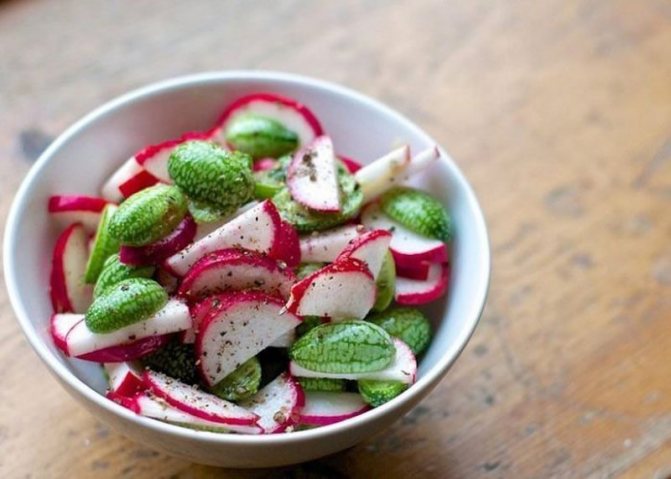

Useful properties of melotria rough
Melotria is a storehouse of fiber, it is indispensable for fasting days and dietary nutrition. Constant consumption of melotria in food strengthens the immune system and vascular walls.
The composition of melotria includes: magnesium, iron, potassium, calcium, phosphorus, sodium, in addition: vitamins B9 and C.
The consumption of melotria stimulates the heart, restores blood pressure, and reduces the amount of cholesterol in the blood. This vegetable is useful if you want to reduce and normalize your weight, since with a low calorie content (15 kcal) it can cause a feeling of satiety. Studies of the composition of the plant have shown that it has a tonic, tonic and anti-inflammatory effect on the body.
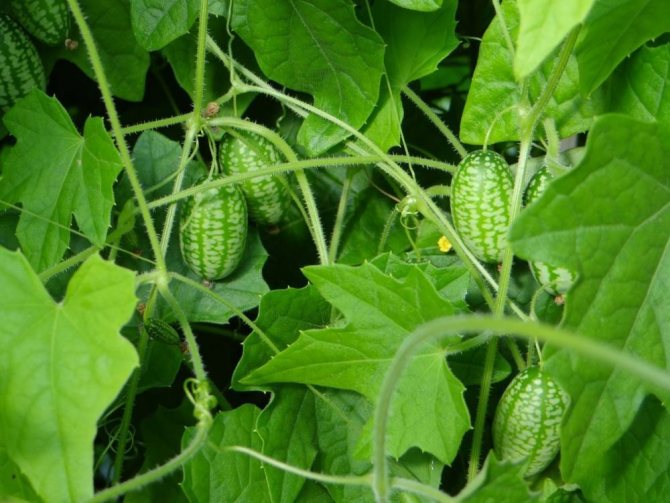

Harm and contraindications of melotria rough
For all its usefulness, fresh fruits of melotria are not recommended for people with high acidity, gastritis and stomach ulcers.
Ripe pickled or pickled mini-cucumbers should not be used by pregnant women, people with diseases of the kidneys, liver, gastrointestinal tract, cardiovascular system, suffering from hypertension,atherosclerosis.
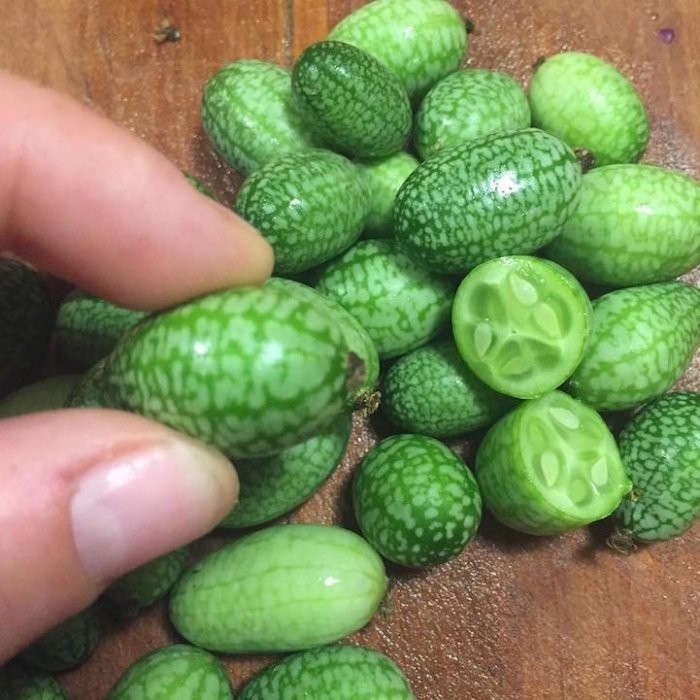

What a plant melotria
The fame of the Mexican liana cannot be compared with its "fellow countrymen": potatoes, corn and tomatoes. This vine is native to Central America, where it received many other local names:
- mouse melon;
- Mexican sour gherkin;
- cucamelon (compilation of english cucumber and melon);
- Mexican miniature watermelon;
- Mexican sour cucumber;
- pepkin.
The origin of these names becomes absolutely clear if you look at the photo of a rough melotria and taste it once. They look like very small watermelons and smell like cucumbers. The taste is also cucumber, but with a slight sourness.
In the Russian-speaking space, the liana received 2 more names: mouse watermelon and African cucumber. At the same time, the second name has no grounds. Melotria is not an African cucumber and has nothing to do with Africa at all. Even to Equatorial.
With a high degree of probability, the confusion was due to the appearance of the fruits. Someone heard that the real watermelon comes from South Africa and decided that the melotria is rough and there is such a wild African watermelon. False information spreads quickly these days.
In fact, rough melotria was domesticated in Central America. Researchers believe that this happened even before the European colonization of the continents.
Description
Melotria rough is a perennial vine from the pumpkin family. Belongs to the genus Melotria, numbering about 166 species. Most of this genus can only be used as ornamental plants. The fruits of melotria rough are also eaten.
Vine leaves are three-segment, triangular in shape. Pubescent. All 3 segments have sharp ends. The plant is monoecious. Both male and female flowers grow on one liana. The males are collected in knots of several pieces, the females grow one by one. Flowers are yellow, funnel-shaped. The lash grows up to 3 m over the summer.
Important! The peculiarity of melotria rough is the flowering of female flowers earlier than male ones.
In the homeland of lianas, mouse watermelons or melotria are considered a weed. Well deserved. This is an unpretentious weed. Like any self-respecting weed, melotria rough does not put all its eggs in one basket, multiplying only by seeds. By the end of the vegetative period, tubers are formed on the roots of melotria rough by the end of the vegetative period, which allow the plant not to spend 3 weeks next year for seed germination.
In hot climates, the tubers on the roots will not allow you to finally destroy the once planted rough melotria. Although sometimes such a need arises. The Mexican liana is an aggressive plant. If it grows on the ground, then it suppresses any other shoots. But in Mexico and tropical America there are no subzero temperatures, while in Russia, even in the south, the thermometer in winter drops below zero. Therefore, in Russia, the liana passes into the category of annual plants and can only reproduce by seeds.
Important! It is better to dig up tubers in the fall and eat them quickly, they have a sweet taste, but they are not stored in the absence of certain conditions.
Advantages and disadvantages
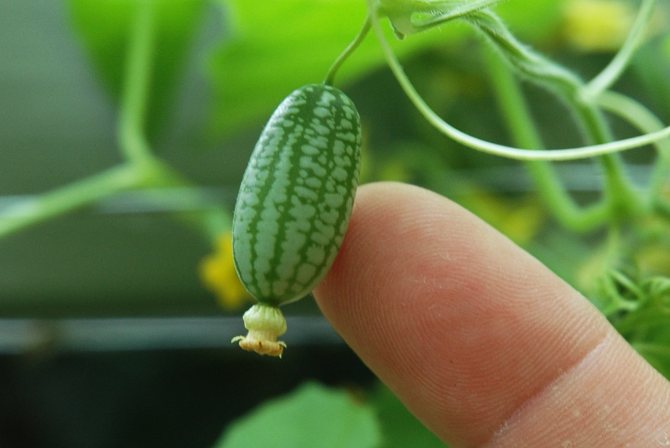

According to gardeners' reviews, "mouse watermelon" has the following advantages:
- quickly begins to bear fruit;
- fruits have an interesting shape and color;
- the liana quickly grows into a thick green wall;
- unusual taste of vegetables;
- versatility of the use of fruits;
- unpretentious care;
- rarely affected by disease.
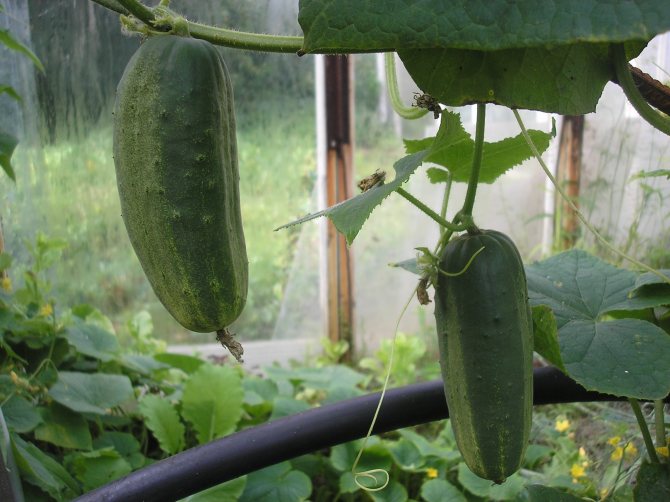

You may be interested in:
Description and characteristics of the variety of cucumbers Parisian gherkin: planting and care Cucumbers are small and neat in shape are called gherkins. Their length rarely exceeds 11 centimeters, they are good ... Read more ...
Of the shortcomings, gardeners note the aggressiveness of melotria. You should not grow African cucumber with ordinary pumpkin seeds in the same garden. In a few weeks, rough creepers will fill all cultures.
Varieties of melotria rough
Given the theoretical duration of the domestication period for melotria, there should be hundreds of varieties today, differing in color, flavor, and size. In reality, there are only plants with berries about 3 centimeters long and color variations within the normal range.
Among the European colonizers, neither in America nor in Europe there is talk about any varieties of this plant. On Western sites, they actively sell seeds and give instructions for growing rough melotria, but they do not mention a word about the varieties. All references to a particular variety refer to Russian firms that sell seed. Therefore, you need to be careful about the problem of varietal reproduction of melotria rough. That does not negate the high qualities of this plant. But "mouse watermelons" are still an "unplowed field" for breeding firms. Yes, and during the sale it is often indicated that the variety is new.
Melotria Hummingbird
There is no data on the distinctive qualities of the Kolibri variety from the usual Melothria scabra. Therefore, it is not known whether it is really the originator of the variety, or they simply named the seeds of an ordinary wild vine that way. The description of the variety boils down to Melothria scabra, and the method of growing melotria of the Kolibri variety is no different from the “cucumber” one.
This is correct, since the main terms of sowing and further care in a mouse watermelon really almost completely coincide with a cucumber vine. Even in abundant watering, they need the same.
Melotria Mini cucumber
Strictly speaking, even the name indicates that this is not a variety, but simply someone did not have enough imagination to describe the berry, or tracing paper from the English "guerkin" - gherkin was used. This is not a cucumber, as there are certain differences. The minimum is a different kind of plant. Outwardly, the berries are also unlike gherkins.
But the principles of growing and harvesting are the same as those of cucumber crops. Only here you don't need to pinch.
Melotria Shapito
But here, on the contrary, someone has a rich imagination. Manipulations with the "varieties" of a wild plant cannot be called anything other than a circus. You can safely buy, focusing on the botanical description of melotria rough. Liana is really well suited for decorative landscaping of balconies, gazebos and fences. The main thing is not to buy an inedible species of this kind of plants.
Melotria Baby
Also a fair name. Berries up to 3 cm in size cannot be called otherwise than babies. But this word is not suitable as a variety name. The berries are small anyway. How much smaller to make them.
Melotria rough Mouse melon
The Mouse Melon variety does not exist. This is a "common" common name for rough melotria. Along with the "mouse watermelon". In fact, "mouse melon" is the wild ancestor of the cultivated rough melotria. But on sale there are packages with seeds called "mouse melon". You just have to remember that this is not a specially bred variety.
The benefits and harms of rough melotria
Even in the western market, these fruits have appeared and have become fashionable quite recently. In America they are called the "forgotten heritage." Due to the lack of data on the beneficial properties of melotria and contraindications to its use, no one can reliably tell yet, therefore, they are guided by the cucumber and the obvious properties.
There is a lot of fiber in any fruit or vegetable with a tough skin. Therefore, berries contain a lot of fiber, which helps to normalize bowel function. Also, melotria contains micro and macro elements:
- calcium;
- sodium;
- magnesium;
- phosphorus;
- potassium;
- iron.
They are found in any plant, since the development of flora is impossible without them. Vitamins C and B₉ are present in fruits. Mouse melon also contains some kind of acid. Most likely, it is oxalic or lemon. But there may be other types of acids, due to which the melotria rough berry has a sour taste.
Melotria is useful for dieting.To the same extent as a cucumber. It is just as watery and low in calories.
Important! Cucumbers are substituted with fruits of melotria in salads.
Contraindications so far also indicate the same as for cucumber:
- increased acidity in the stomach;
- gastritis;
- stomach ulcer.
Melotria is somewhat more dangerous than cucumber due to its high acid content.
Pickled fruits are not recommended for people with certain diseases of internal organs:
- gastrointestinal tract;
- of cardio-vascular system;
- liver;
- kidneys.
Do not abuse salted or pickled melotria for people with hypertension and atherosclerosis.
Growing melotria from seeds
Growing melotria rough from seeds methodologically again coincides with cucumbers. Breeding Melotria is a little easier, as it does not even require the care that cucumber bushes need.
Seeds of mouse melon for seedlings are planted at the same time as cucumber ones: in February-March. The vine is not demanding on the soil and grows well in loamy soil. But for seedlings, it is better to choose nutritious soil. The one that goes for cucumbers will do.
The seed is simply pressed into the ground with a sharp end and thoroughly watered with warm water. For the germination of rough melotria, an air temperature of + 24 ° C is needed. On Russian-language sites, by analogy with other pumpkin seeds, there is information about the germination of melotria seeds within 3-5 days.
Foreign sites "unanimously" assert that the main difference between Melotria rough and its "relatives" is a very long germination time. Vine sprouts take 3-4 weeks to emerge from the ground. And the higher the air temperature, the faster the seeds will germinate. Therefore, if the purchased "varietal" seeds did not germinate after a week, you need to wait another 3 weeks before being disappointed and throwing out melotria. Germination is best done on a sunny windowsill. The earth should also warm up. After the first 2-3 true leaves have developed, the air temperature can be reduced to + 18-21 ° C.
Important! Melotria feels great in an apartment on a well-lit windowsill.
Seedlings are planted in a heated greenhouse in March, in an unheated one in May or even later in open ground. The planting scheme is the same as for a cucumber. At first, the vine grows very slowly, but then development accelerates. Melotria should not be left to curl on the ground, it begins to rot. For this, the plants are placed retaining walls or trellises. You can make a hedge out of vines.
The site for planting is chosen protected from the wind and well warmed up by the sun. You cannot plant mouse melon where other pumpkin species grew last year. As a relative, it is susceptible to the same diseases and pests. Melotria is hygrophilous. The soil under the vine should always be moist.
Important! It is necessary to water the soil, avoiding the ingress of water on the leaves.
Reviews of summer residents
I planted melotria around the gazebo. Liana rose quickly. He practically did not look after her: he did not introduce fertilizers, he did not cut the stems. Melotria covered the whole arbor. The leaves began to turn yellow and fall off in mid-October. Cucumbers, a little sour in taste, also pleased.
I came across a melotria, some kind of same-sex. There were practically no inflorescences of two flowers. Neighbors, summer residents advised to plant new seedlings. This time I was lucky. Inflorescences appeared on the stems from one flower, and from two. Fruits began to appear on the "old" plant as well. Apparently pollination reached them. I planted it like a pumpkin. I made round beds... The granddaughter enjoyed the little cucumbers most of all, but did not eat them. The rind is harsh.
She planted melotria in the same way as cucumbers: first in cups on the balcony, then at their summer cottage. I planted one part of the seedlings in a greenhouse, the other in open ground. Cucumbers in the greenhouse appeared faster than in the open air. I tasted them. I didn't really like the fresh melotria. I decided to preserve it along with ordinary cucumbers.It was delicious. My family liked it. I made salad and okroshka from root vegetables. The taste is the same as that of radish.
How to collect melotria seeds
Overripe fruits are used to collect seeds. It is best to pick up berries that have fallen to the ground and leave them on a tray indoors for another 1-2 weeks. After that, the fruits are cut and the seeds are removed from them. The resulting mass is placed in a jar of water and left for 5 days.
During this time, pathogenic organisms have time to die, and the seeds are sorted by quality. The best seeds sink to the bottom of the jar. After 5 days of infusion, the contents of the jar are poured into a strainer and washed well. The seeds remaining in the sieve are laid out on a clean surface in a cool, well-ventilated room and dried for 2 weeks.
After drying, the seeds are transferred to an airtight jar and placed in a cool dry place. With proper storage, the germination of melotria seeds lasts up to 10 years.
Tuber propagation
If you don't want to wait 3 weeks before the first seed germinates, and there are conditions for storage, melotria can be propagated by tubers. In late autumn, they must be dug up and placed in the basement. The tubers are stored in slightly damp peat. They are planted in a permanent place after the ground has warmed up.
Growing benefits
The African exotic plant has taken root well in the Russian open spaces. As an experiment, even a beginner can try to grow melotria on the site. Healthy and well-groomed melotria looks very impressive in landscape design. In the second half of summer, when the tops of other pumpkin plants wither and wither, the beautiful liana retains its attractiveness.
- Cultivated as an annual.
- Grown in seedlings, care - like for cucumbers.
- Loves watering and loosening the soil.
- It is necessary to feed twice with complex fertilizers per season.
A beautiful climbing plant with decorative fruits will decorate not only the most exquisite table, but will also become a spectacular element of flower arrangements. Pamper yourself and your loved ones, order Chapito melotria seeds in our store.
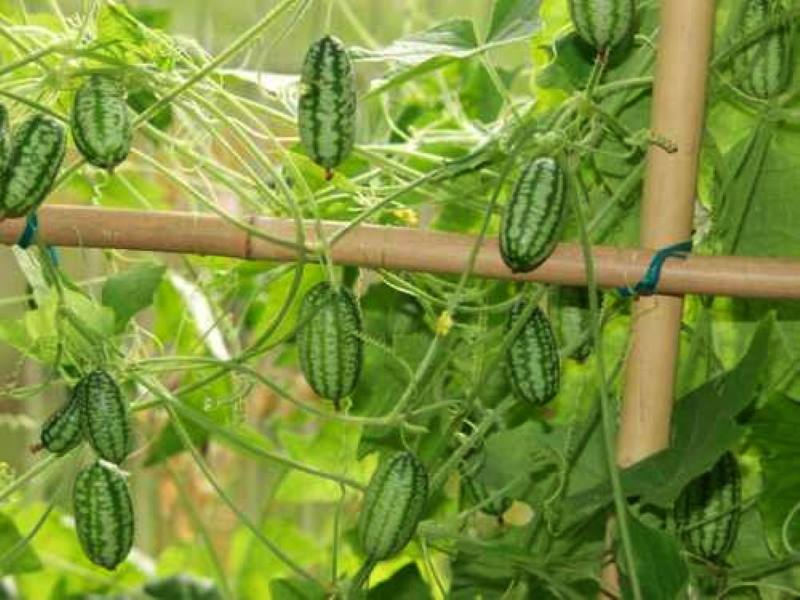

Melotria has small seeds, similar in appearance and size to sesame seeds. Accordingly, the seedlings will be tiny. If you are not afraid to lose them in the garden, you can sow directly into the ground at the same time as the cucumbers. But it is safer to grow through seedlings, then the harvest will be earlier, which means it will be richer. Start sowing in pots in April, about 30–35 days before planting in a permanent place.
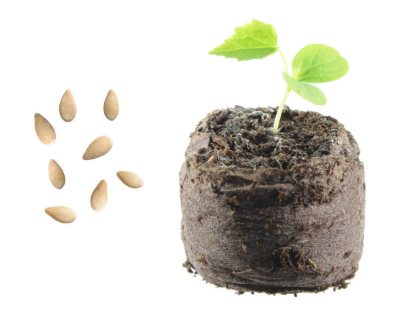

Melotria has small seeds, similar in appearance and size to sesame seeds.
The soil, as for cucumbers, should be fertile and loose. It is convenient to grow such seedlings in peat tablets. If you are used to soaking seeds in stimulants, then treat melotria as well, or you can sow dry seeds. Do not cover them deeply, sprinkle with earth in a layer of 3-5 mm. At room temperature, seedlings will appear in 5-6 days, at 30 ° C - in 2-3 days.
Seedling care consists only in watering, you do not need to feed. Plants in pots will not sit for long, they are small, grow slowly, there is enough food available in the soil. In peat tablets, you can once, after the appearance of the first true leaf, pour a solution of fertilizer for seedlings, for example, Fertiki Lux.
Melotria is an interesting plant, it should be grown at least out of curiosity. Liana does not require professional care. Seedlings need to be grown for only a month, but you can sow directly into the garden. The fruits will look good in a platter, and the tubers are interesting to try.
Melotria recipes
The berries of this liana almost completely replace cucumbers in taste and smell, so there are no special recipes for rough melotria. It is used where cucumbers are used. Rough melotria blanks for the winter are also made according to the "cucumber" recipe.The same goes for salads, pickles, or preserves.
The advantage of this berry is that children really like little "watermelons". Kids don't need to be forced to eat these fruits. Children often eat them right on the spot, tearing them off the vines.
Important! Rough fruits are better suited for canning melotria rough.
Melotria pickling recipe
There are marinade recipes for any product in every family. You can try different ingredients and proportions. In the case of rough melotria, it is enough to choose one of those marinades that are suitable for cucumbers:
- 1 kg of fruit;
- 2 bay leaves;
- 2 dill umbrellas with seeds;
- 5 cloves of garlic;
- ½ hot pepper pod;
- a teaspoon of vinegar essence;
- 70 g salt;
- 100 g of sugar.
Rinse the fruits, garlic, laurel and dill thoroughly and pour over with boiling water. Put in sterilized jars, add salt and sugar. Pour in boiling water and wait until the salt and sugar dissolve. Drain the brine and boil again. Pour the jars again and add the vinegar. Close the covers tightly.
Salting melotria
Open-cut salting is again borrowed from cucumbers. The fruits are poured with brine, to which salt, vinegar and sugar are added to taste. For aroma, put garlic, black pepper, dill root, and other spices. Such a product is intended for quick use, since there is no sterility.
Melotria jam
The recipe for making jam is again borrowed from the cucumber culture, and the technique from the gooseberry. Young fruits are taken for jam. Rough melotria does not need to be peeled, there is too little pulp and a lot of water under it. Cooked for jam from whole fruits. You can prick them with a needle, like a gooseberry.
Ingredients:
- mouse watermelons 500 g;
- 1 lemon;
- 1 orange;
- cinnamon stick;
- star anise asterisk;
- 2 boxes of cardamom;
- 300 g sugar;
- vanilla to taste.
The orange is cut into cubes and pitted. Juice is squeezed out of the lemon. Put all the ingredients in a saucepan, add a little water and put on fire. After the liquid boils, the flame is reduced and boiled until thickened for 40-50 minutes.
Harvesting and processing
Rough melotria ripens pretty quickly. The first fruits can be tasted as early as 3 weeks after planting. You can harvest the fruits when they reach 2-3 cm in length. Small cucumbers can be eaten fresh or used to prepare snacks, first and second courses. They also turn out to be quite tasty when preserved.
Harvesting mini cucumbers "Melotria"
Important!
The fruits and roots of melotria rough cannot be stored for a long time. Therefore, it is not recommended to delay the processing of the crop.
Not only fruits, but also roots are edible in Melotria. After harvesting the fruits, they begin to dig up the roots. They taste like daikon. You can use root vegetables for making soups, mashed potatoes, various snacks and other dishes.
Reviews of growing melotria Hummingbird
Evgeny Afanasyev, 38 years old, Krasnodar The first time he planted melotria out of curiosity. I saw seeds from "Gavrish" in the store. I planted 4 plants per m² on an open bed. At first they grew slowly, and then they filled the entire space. The harvest was given before the first frost. My daughters really enjoyed eating berries straight from the lashes. So next year planted this culture again. I came to the conclusion that for the lashes it is necessary to build rather strong supports, otherwise the support will break under the weight of the fruit. Sergey Nikolaev, 31 years old, p. Cherry Last year I tried to grow this plant. I really liked it. It is really unpretentious and gives a lot of fruits. But I met claims that mouse melon can also be grown in pots as an ornamental plant. Her foliage is very thick and beautiful. Next year I will put a couple in hanging pots. As long as they are green, they should create a very nice composition. The vine grows magnificently, giving many new shoots. So the plans are to get a nice green bush in the air.Evgenia Vasilchuk, 46 years old, pos. Light For the sake of experiment, I planted five seeds per garden bed and in pots. At first, the plants developed slowly, and then they began to grow. Those that were grown in pots yielded fewer fruits than the "garden" ones. I collected 25 pieces from the beds every day. More than enough for a daily salad in my opinion.
Melotria rough is a completely new plant for Russia. It turned out to be not quite old for "native" America either. Due to its unpretentiousness, it will be able to replace cucumbers, since these plants are the same in terms of thermophilicity, and the hassle with a mouse watermelon is much less.
Where to plant an exotic plant?
Melotria is rough, originally from warm countries, and therefore has a love for the sun and warmth in its genes. The ideal place on the site will be the south side, well lit from all sides, where the sun, rather than shadow, "dwells" most of the day. Although many gardeners grow it in partial shade, this option is also fine. The soil is loose, nutritious.
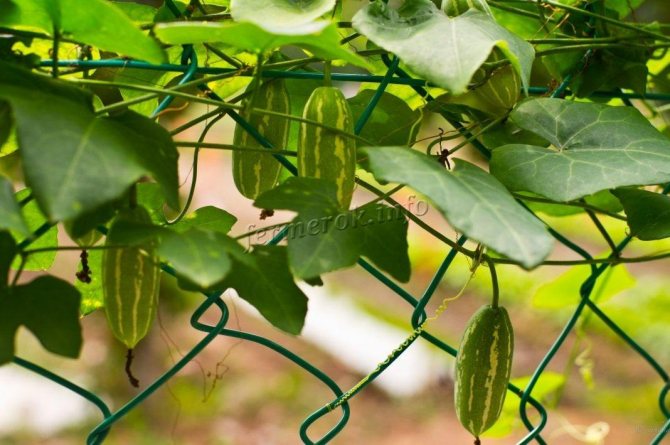

Lovers of the exotic grow melotria as an ornamental culture
Onions, peas, and tomatoes are considered good predecessors. But after melon crops, hummingbird melotria grows poorly, because it often gets sick, and can be affected by pests from an early period of development.
Melotria: what is it?
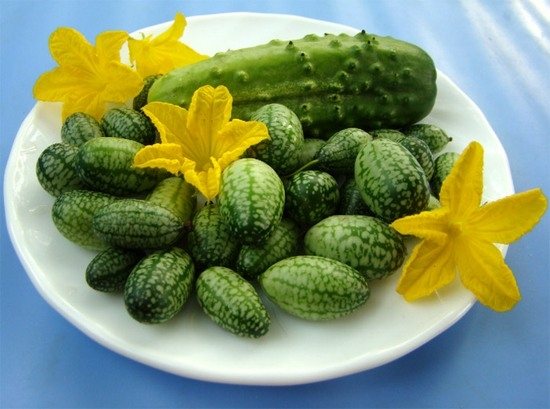

The fruits of the African cucumber have a unique taste. In the process of ripening, they acquire a rich green color with light stripes. The size of the fruits is not more than 2.5 cm. You need to collect mini-cucumbers at a time when they are still small, since there will be many grains in large fruits.
In almost all cases, the fruits of the plant are eaten in raw form, added to salads, can be salted, pickled like simple cucumbers. To make the fruits of melotria more tasty, it is recommended to add a small amount of simple hot pepper during pickling. African cucumber goes well with a variety of fish, vegetable and meat dishes.
Melotria contains valuable fiber. It is this substance that contributes to the accelerated and completely safe removal from the human body of not only toxins, but also bad cholesterol, which is very dangerous to health. This property has made the fruit not only effective, but also a completely natural remedy that helps get rid of constipation, even if it has become chronic.
Melotria is widely used in cooking, while both the fruits and tubers of the plant can be used (in appearance they resemble a sweet potato). The root vegetables themselves have a very interesting taste that resembles radishes and the usual cucumbers.
It is also widely used in folk medicine, since the vegetable contains a huge amount of valuable substances and minerals. Melotria is useful to use during the course of medical therapy for various diseases.
Despite a lot of positive properties, the use of melotria also has certain prohibitions. Fruits can cause serious harm to health if the level of acidity of gastric juice is high. For various diseases of the kidneys, as well as the liver, it is worth giving up pickled or pickled African cucumbers. You can not use melotria and in the presence of various problems in the work of the cardiovascular system and malfunctions associated with the functioning of the gastrointestinal tract. African cucumber is categorically contraindicated for gastritis and stomach ulcers.
Rules for growing cucumbers in a greenhouse
When to Harvest?
Mini cucumbers will appear 2 weeks after transplanting. After another week, you can collect them. This happens at the end of May, beginning of June. Melotria can overripe quickly. The fruit becomes soft, with a yellow tint. If the summer resident has a goal to collect seeds, then you need to wait for the full ripening of the fruit. For eating, pick green fruits, no more than 4 cm long.
From fruits and roots of melotria make vegetable salads... You cannot leave it in the refrigerator for a long time, for a maximum of three days. It loses its properties. Cucumbers can be preserved for the winter. The jar will look beautiful if the fruits of melotria are added to the squash and Kryushon.
Melotria rough: growing and care
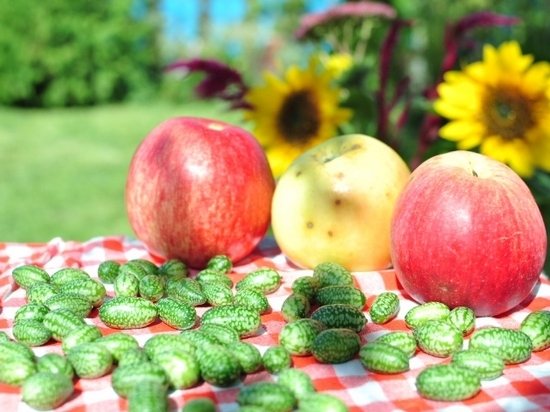

- Care and cultivation of melotria, regardless of its variety, is practically the same as for simple cucumbers. The African cucumber is planted at the end of April - plastic cups are filled with an earthen mixture and exactly 2 seeds are placed in each. The seeds are very small and can be simply put on the surface of the ground without burying. From above, the crops are watered with a small amount of water (only settled), covered with bags. All cups with seeds are placed on a well-sunlit window.
- The first shoots will begin to appear on about 3-4 days. As soon as the sprouts reach a few centimeters in height, you need to periodically open the window during the day so that they begin to gradually harden. Transplanting seedlings is performed in mid-May, and so that it does not die from night frosts, you need to cover it with non-woven material.
- It is necessary to place beds with melotria in a well-lit place or in partial shade. The ideal option would be the land on which tomatoes or legumes used to grow. You should not plant the plant in areas where there used to be zucchini and pumpkins, as their diseases can also be transmitted to the African cucumber. The distance between the beds should be at least 40 cm.
- You can plant the plant immediately in open ground, however, in this case, Melotria will begin to bear fruit much later. If the plant will be used as a decorative decoration for garden pavilions or fences, then you can stop at this growing method.
- You can also plant melotria in hanging containers on balconies, but then you need to constantly prune the growing shoots. The result is a very cute and unusual ampelous plant.
Melotria
Care advice
Growing mouse watermelons need frequent watering. It is desirable to water them with warm and settled water. It is imperative to weed the soil from weeds and loosen it for oxygen access to the plant's root system.
Feed during growth, flowering and fruiting with potash and phosphorus compounds.
Mineral fertilizers are suitable for vegetable crops, determine the dosage according to the instructions. The watermelon cucumber does not need to pinch the shoots, it bushes well and bears fruit so well.
As a prophylaxis against diseases, spray with soapy water at the beginning of summer and at the end.

